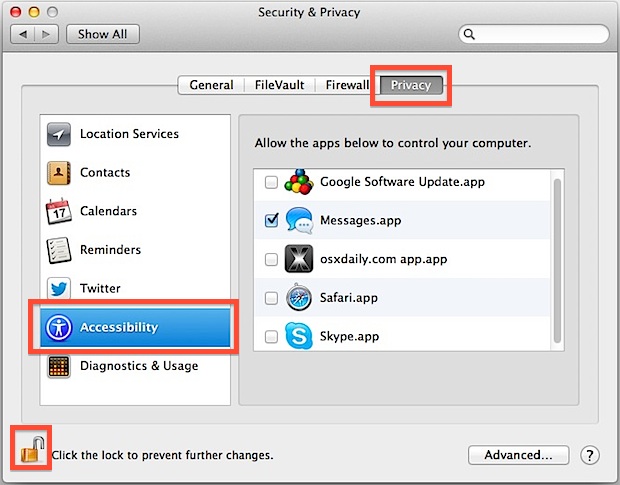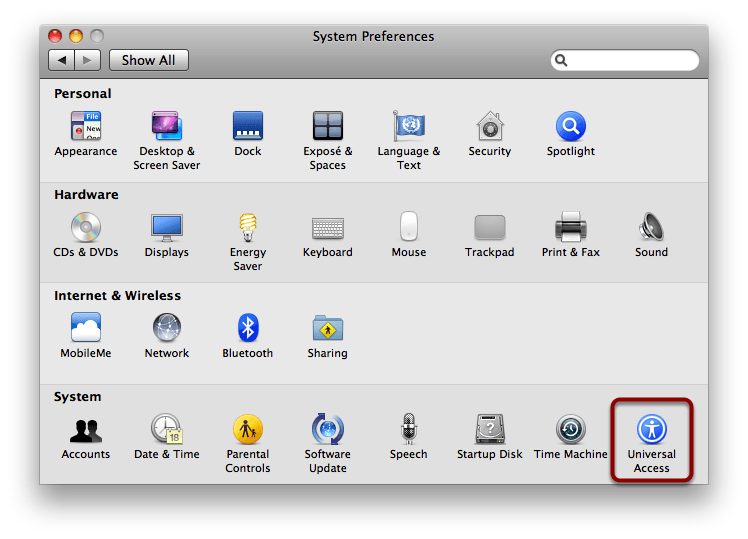How to Enable Accessibility on Mac OS X 10.10 Yosemite. Open System Preferences Security & Privacy. Click the Privacy tab. Click the lock icon to make changes. Select Accessibility from the list. Similar to the post on this page about Mac OS X 10.9 (Mavericks), to resolve this issue on Mac OS X 10.8 (and likely on earlier versions of OS X also), you need to ensure that the 'Enable access for assistive devices' option has been enabled in the Accessibility pane of System Preferences. From the the Mac, simply select the file in the Finder window, then click the Share button in the toolbar. Select AirDrop, as shown above. You will then see icons for any Yosemite Macs, iPhones, or iPads that are nearby. If no icons show up, but you know there is a Yosemite device nearby, you will see this message.

| Click here to return to the 'Enable automatic login with automatic screen lock' hint |
Mac Yosemite Access For Assistive Devices El Capitan
Question: will this work if I otherwise set my screensaver to 'Never' turn on? I'd like to restrict login access to the machine (which is in a semi-public space), but once logged in keep the screensaver from coming on.

Yes, it should -- the 'Never' setting is just how long the computer will wait before activating the screensaver application when you're idle, whereas this just opens it at login.
How are about this:
/System/Library/CoreServices/Menu Extras/User.menu/Contents/Resources/CGSession -suspend > /dev/null
How to format wd my book for mac. Um, couldn't this 'security' be bypassed by holding the shift key at startup?
First rule in security: If someone has physical access to the machine, it isn't secure.
For example, even if the screen was already locked, someone can just come up and pull the power cord and hold command-S when restarting the machine. All security is bypassed.
If you have an open firmware password, the person can simply open the case, pull a RAM stick and restart the machine.
This method is pretty good for locking down a machine in a trusted environment; i.e. one where you don't expect people to deliberately work at compromising your machine, but might mess you up without intending to do so or see something they shouldn't (like a payroll spreadsheet) if your machine wasn't locked at all.
FYI in case anyone was wondering..
Changing RAM configuration on a machine protected by the Open-Firmware Password disables the password.
---
Rick alias cougar
If you use FileVault though, you do have some protection, since the attacker will have to find a way to decrypt the files, which is really hard. The downside is that FileVault is a little buggy? or at least seems that way in the reports I've read.

safe boot disables automatic login, at least in tiger.8 (goes to login window).
for a shell script which you can run at log-in. You can adjust the idle time to less if you want the screen saver to kick in quicker.
I use OSX-vnc to do this. It has a startup item so it can run in the background of the login screen. I can remotely login using the vnc password, and then login using the computer account. I can also lock the machine using fast user switch/login window. It is not seemless though, I usually get kicked off vnc upon logging in/out, and i must re-login the vnc session.
Printer Driver. The latest Brother original Printer Driver for macOS v10.14.x is available from the Downloads section for your model on the Brother Solutions Center. The Printer Driver includes the CUPS Printer Driver, BR-Script Driver (PS Driver), PC-FAX Driver and Brother Status Monitor. The availability of the drivers and utilities vary depending on the model number of your machine. Support & Downloads. MacOS Support Statement. MacOS Catalina (macOS v10.15.x). Most models offer support for macOS Catalina (macOS v10.15.x). To view a list of supported models along with download links to drivers and software for your Macintosh click on the link for your product type below. https://recipelucky.netlify.app/brother-printer-drivers-for-mac-os-mojave.html. The latest Brother original Printer Driver for macOS v10.15.x is available from the Downloads section for your model on the Brother support website. The Printer Driver includes the CUPS Printer Driver, BR-Script Driver (PS Driver), PC-FAX Driver and Brother Status Monitor. The availability of the drivers and utilities vary depending on the model number of your machine. For the product-specific information.
I knew someone else would have worked this out for me. Excellent!
Mac Yosemite Access For Assistive Devices 2017
This is really bad security. If an attacker has physical access to your machine, holding down shift while it automatically logs you in will disable the Login Items and then you're wide open.
Of course if they have physical access and half a clue, you're probably screwed at that point anyway.
Mac Yosemite Access For Assistive Devices Free
On the VNC route, user-based server apps (Vine Server, etc) can give you access to your desktop while a login screen is displayed (user switching required) but you'll get odd results from a context that isn't in charge (think audio and video hardware access. Some apps can crash or misbehave). This can give you to the GUI, albeit not 100% compatible, but still a step up from just command line.
Alternatively, I think if you enable Remote Desktop with VNC access enabled, that being system wide, you can actually access the login screen by remote. The downside is of course, you can't hide behind the login screen like you can with a user-bound server app, but has the advantage that its always present, and autologin isn't needed. Also, the built-in server doesn't support all the traffic-reducing features of user apps, but I think this solution will become much more useful in Leopard. Apple is touting Screen Sharing as a real feature. Imagine it combined with back-to-my-mac (personal VPN, requires .Mac)
Killer combination of features.
http://www.apple.com/dotmac/backtomymac.html
Mac Yosemite Access For Assistive Devices Mac
! Note: But it doesnt work with filevault.
Please bear in mind that useing login hooks can render your machine un-usable. To safeguard against such events its recommended to write down the restoration command on a piece of paper. Login hooks are run as root, they can be disabled from single-user mode (press 's' on startup).
This above script is nice under normal circumstances because you dont really notice it and no 'second wait' while user account is still loaded.
Mac Yosemite Access For Assistive Devices Windows 7
jason209 - nice script, however under Snow Leopard this causes the system to just display a blue screen after you click the 'Already Logged In User' and enter your password (logging into another account, such as the Guest Account, works fine).
Any ideas how to get this working with Snow Leopard?